10 Workout Moves You're Probably Doing Wrong (And How to Fix Them)
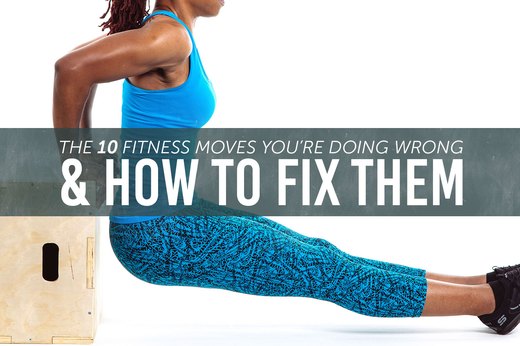
Describe the Fauna
Overview
You don’t have to hire a
personal trainer to start a new exercise program, but it’s important to
realize that there is a science to each of your favorite
strength-training moves. As a trainer, I see many people depend on their
own knowledge and very few professional resources to guide them, and
these are the most common mistakes I’ve watched people make. When
performing these 10 strength-training exercises, the main thing to keep
in mind is that the beginning of all movement starts with the core. By
engaging your core, these exercises can be executed with more
stabilization, power and strength.
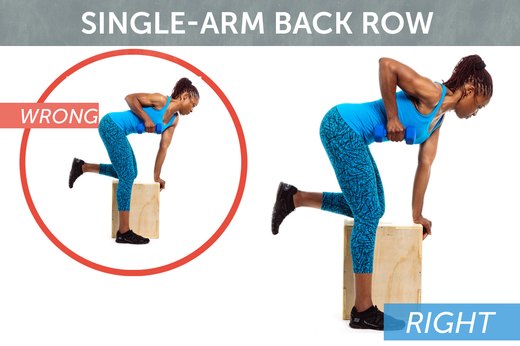
Describe the Fauna
1. Single-Arm Back Row
Although the biceps and forearm are also being
used in this exercise, the primary muscle is in the back, so the focus
of this exercise needs to be on the back muscle pulling the weight in
the hand up from its starting position. Often, people just contract
their biceps muscle to move the weight without using much of their back
muscles at all. To perform this move correctly, the arm must remain
relaxed with no intentional contraction of the biceps. The back is flat
throughout the exercise with minimal to no torso rotation, with the back
doing the majority of the work.
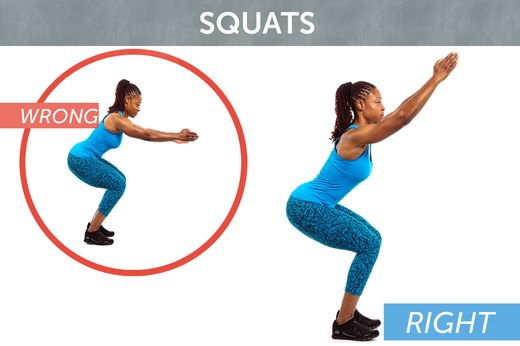
Describe the Fauna
2. Squats
The common mistakes I’ve seen made are:
lifting the heels by putting the weight on the toes; allowing the knees
to move out over the toes; and not keeping the torso upright. Doing
squats in that manner puts too much pressure on the knees and can cause
serious injury, especially when weight is added. The muscles being used
in a squat include the quadriceps, hamstrings and glutes. When
squatting, think of your butt reaching for a chair to sit down in, with
all of your weight distributed to your heels. The hips hinge at a
90-degree angle, the knees should be at a 90-degree angle and the torso
should remain upright.
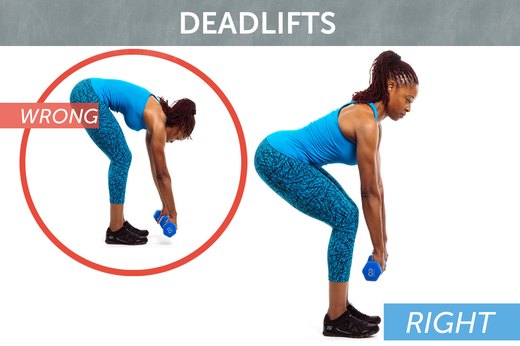
Describe the Fauna
3. Deadlifts
This hamstring-dominant exercise is often done
in a way that can cause injury to the back. Although the back is
involved in this exercise, the typical mistakes include bending over too
much, rounding of the upper and/or lower back, not keeping the weight
close to the body and contracting the shoulder blades back together.
However, the shoulders need to be stabilized, arms straight, lower back
in its natural curve and neck in a neutral position. The hands remain
close to the legs throughout the movement. Your legs are slightly bent,
and your core is tight as you hinge forward at the waist and push the
glutes backward. When coming up from the bent-over position, squeeze the
glutes and bring the hips forward.

Describe the Fauna
4. Push-Ups
What’s the typical bad push-up form? A minor
bend of the elbows while the hips dip toward the floor and the head
hangs. Instead, have your hands placed parallel to your chest on the
floor. Angle your elbows out for a chest-focused push-up or right next
to the body and pointing back for a triceps-focused push-up. Think of
pushing your body away from the floor using the chest muscles with a
neutral head position, and then lower the body back to the floor in a
controlled manner.
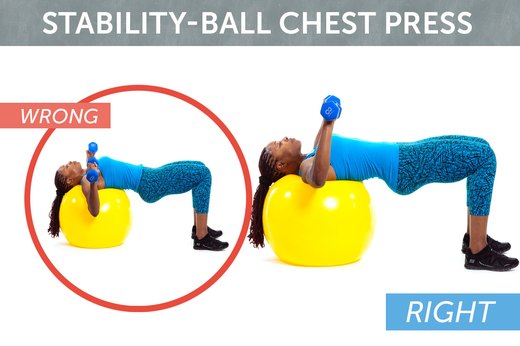
Describe the Fauna
5. Stability-Ball Chest Press
The focus of this exercise is also the chest
muscles, but many people make the mistake of not stabilizing their
shoulders and allowing their arms to drop too far back on the ball,
creating the momentum by bouncing the arms on the ball to lift the
weights. For this exercise, the shoulders need to be stabilized and the
elbows bent at a 90-degree angle. The contraction should be of the chest
muscles while the arms are straightened over the chest (not the face)
at the top of this move. Return back to a 90-degree angle at the elbow
and repeat.

Describe the Fauna
6. Front and Lateral Shoulder Raises
When executing this move, many raise the
weights too high and go beyond the contraction needed to strengthen that
muscle. To do it correctly, stand with your feet at shoulder width,
core tight, your knees slightly bent and arms straight down in front of
your legs. Raise the weights to the height of your shoulders, engaging
the anterior deltoids, and then return to the starting position. The
same goes for the lateral shoulder raises: The arms should remain
slightly forward without contracting the shoulder blades back. When
raising the weights, the pinky finger is slightly higher than the rest
of the hand.
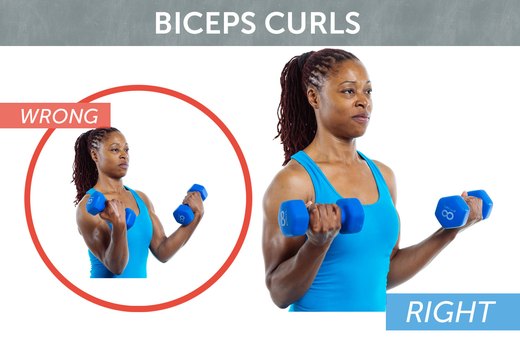
Describe the Fauna
7. Biceps Curls
This seems too simple to be done wrong, but
people still find a way to mess it up, like not keeping the elbows down
next to their sides, allowing their arms to swing using momentum to move
the weight and not taking the elbow joint and biceps muscle through the
full range of motion. I also see people curling their wrists during
this exercise, which works more of the forearm. The start of the
movement is with the elbow somewhat planted at your side with a straight
arm. Think of a string running from the front of your shoulder to the
weight in your hand. That string should pull the weight in your hand
toward your shoulder while you squeeze the biceps at the top of the
movement. That is the concentric part of the exercise. The eccentric
motion is lowering the weight back down to the starting position, which
must be controlled because it’s still an important part of the exercise.
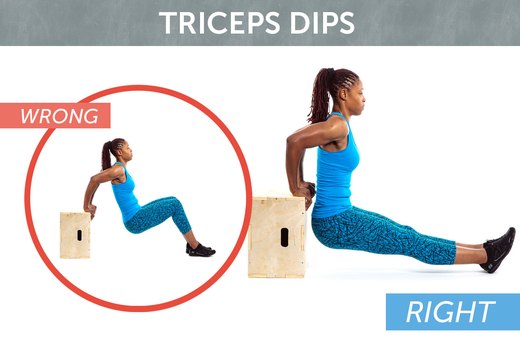
Describe the Fauna
8. Triceps Dips
While some people avoid this move because of
the pressure it puts on the shoulders, many people are doing it in a way
that can cause shoulder injury. Some make the mistake of overextending
their shoulders by not keeping their torso and butt close to the bench
or step. If it’s too hard with your legs straight, modify it by bending
your knees, not by moving further away from your stable base. Perform
this exercise using a bench, step or chair with your torso upright and
close to your stable base. Start with your arms straight and hands
facing forward. Bending at the elbow, lower your body toward the floor
and return to the starting position by contracting and pressing through
the triceps.
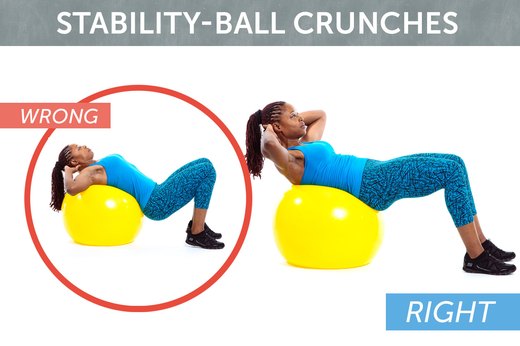
Describe the Fauna
9. Stability-Ball Crunches
I have seen people pick up a heavy medicine
ball and go to town doing what they think are crunches on a stability
ball, when, in fact, they’re working more of their hips and calves than
their abs. If you’re not feeling the burn in your abs, you’re probably
doing something wrong. For stability-ball crunches, your hips must
remain stabilized. Have your head in a neutral position to take the
strain off your neck. Your abs should be engaged and your focus on using
the contraction of the abdominals to lift yourself up.











0 comments:
Post a Comment